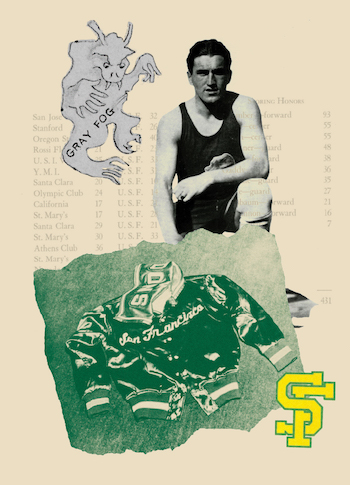
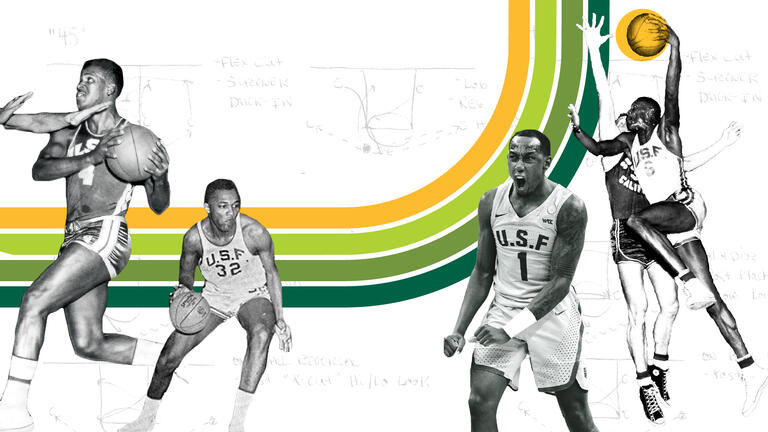
Hoop Dreams
Bill Cartwright has no doubt about the potential for USF’s men’s basketball. He played on USF’s best teams in the 1970s, led the Dons to three NCAA tournaments, and graduated from the program to become a five-time NBA champion.
Cartwright, now director of university initiatives, knows what USF can do on the basketball court. Greatness at a national level. That dream is still alive on the Hilltop.
“If your intent is to win and be the best, that’s what you are capable of doing,” Cartwright says. “Everybody here is on the same page. Everybody here wants to win.”
The Dons’ recent success includes a trip to the 2021–22 NCAA tournament, a reminder of what is possible.
In 2022–23, under first-year head coach Chris Gerlufsen, the Dons went 20–14 with a win in double overtime against Santa Clara in the West Coast Conference (WCC) quarterfinals. The Dons hit the 20-win mark — a badge of success in college basketball — for the sixth time in seven seasons.
“With the tradition and history here at USF, it’s my goal and the staff’s goal to bridge the past with the future, get us back to being a top-25 program and being talked about as a top-25 program again,” Gerlufsen says. “There are not many programs that have the tradition and the accolades that we have going for us.”
That tradition includes 14 WCC championships, two NCAA titles, and an NIT championship at a time when the New York-based tournament determined the nation’s best team. After leading USF into the post-season last year, Jamaree Bouyea became the 26th USF player to join the NBA.
At the top of the pro list is the late Bill Russell, who died in July 2022 at 88. One of the greatest winners in all of American sports, he had 11 NBA titles, two NCAA championships, and an Olympic gold medal on his Hall of Fame record.

A Parade, a Chevrolet, and the Gray Fog
As Gerlufsen prepares the Dons for another season in the WCC, the school is celebrating a milestone: This season marks the 75th anniversary of the basketball team being honored with a ticker-tape parade through San Francisco’s financial district, followed by a banquet at the Fairmont Hotel. After the festivities, head coach Pete Newell was presented a new Chevrolet sedan.
The date was March 22, 1949, and the school and the city were celebrating the Dons winning the NIT. At the banquet, Newell thanked James Needles for “teaching me everything I know.”
Jimmy Needles started it all. He played and then coached basketball for what was then St. Ignatius College before World War I, and the Gray Fog received national attention in 1928–29 by going 21–2 and winning the Pacific Coast championship.
The St. Ignatius Gray Fog became the University of San Francisco Dons in 1932. Needles became coach at Loyola of Los Angeles (now Loyola Marymount). Two of his players there were Pete Newell and Phil Woolpert. Needles remembered both when he returned to USF as athletic director in 1941 during World War II.
Needles hired Newell to be the USF coach in 1946. By 1949, Newell had assembled a powerhouse lineup with Don Lofgran, Joe McNamee, John Bennington, and Rene Herrerias.
The Dons dominated the West Coast with a 21–5 record, then headed to New York for the NIT in Madison Square Garden. They brought home the title with four straight wins.
USF was officially a national basketball powerhouse, with the best yet to come. Newell moved to Michigan State and Woolpert became coach.
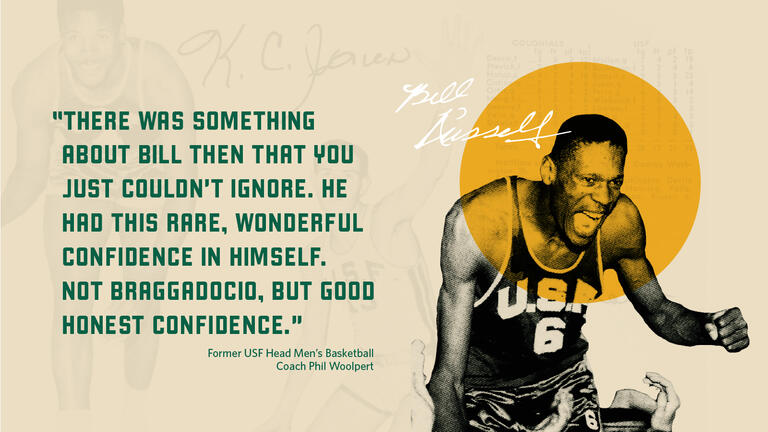
The Bill Russell Era
As Woolpert worked to keep USF at a high level, he had an edge over other teams. He recruited Black players at a time when other teams wouldn’t. One of USF’s first Black players was guard K.C. Jones from San Francisco’s Commerce High School.
USF found another strong player across the bay, a tall, skinny center at Oakland’s McClymonds High School. No other university was interested in Bill Russell.
“He could jump — oh, how he could jump — but he was so ungainly,” Woolpert told Sports Illustrated. “Still, there was something about Bill then that you just couldn’t ignore. He had this rare, wonderful confidence in himself. Not braggadocio, but good honest confidence.”
As a sophomore at USF in 1953–54, Russell averaged 19.9 points and 19.2 rebounds per game.
Jones, who missed most of his junior season because of a ruptured appendix, was given an extra year of eligibility and in 1954–55, he and Russell were joined by guard Hal Perry. Three Black players in the starting lineup was rare in college basketball at the time. The Dons went to a tournament in Oklahoma City, and the entire team slept in a vacant dormitory because their hotel would not allow Black players to stay there.
The Dons lost their second game of the season to UCLA and wouldn’t drop another for two years. That 60-game winning streak was an NCAA record that stood for 26 years and remains the second-longest in college basketball history.
The Dons romped their way to the NCAA championship in 1954–55 and repeated the following season. Russell was unstoppable, and USF wrapped up a second straight title with an 83–71 victory over Iowa.
After he left the university, Russell and USF had a fractured relationship, in part because the school asked him to pay tuition for the final 16 credits he needed to complete for a degree.
Russell went on to be a leader in the NBA, on and off the court, with the Boston Celtics. He joined Black teammates who boycotted a 1961 game because his former USF teammate — and current Celtics teammate — K.C. Jones and another player were turned away from a restaurant because they were Black.
Even though Celtics fans slammed Russell for years, he stayed with the team, leading Boston to 11 NBA championships. He also worked with the NAACP, advocating for civil rights in the 1960s.

UCLA’s Biggest Threat on the West Coast
As the Dons moved on without Russell, Jones, and Perry, the team kept winning. In 1956–57, Gene Brown, Mike Farmer, and Art Day led them to a 21–7 record and a third straight trip to the NCAA tournament. This time they went up against Wilt Chamberlain and Kansas, losing in the semifinals.
In 1957–58, the Dons were 24–1 going into the tournament but were knocked out in the first round by Seattle and Elgin Baylor. The next season, 1958–59, USF moved into the $1.2 million War Memorial Gym. No longer would USF have to practice in a neighborhood gym or play at Kezar Pavilion.
The Dons would remain one of the strongest teams on the West Coast for more than two decades. There was just one roadblock, a school that would break USF’s winning streak and build the greatest dynasty in college basketball history.
Under John Wooden, the UCLA Bruins won 10 national titles in 12 years from 1964–75. For much of that run, USF was UCLA’s biggest threat on the West Coast.
Pete Peletta became USF’s coach in 1960–61 and built another powerhouse. Leading the way were center Ollie Johnson and forwards Dave Lee and Joe Ellis.
In 1963–64, guard Jim Brovelli led the team to 12–0 in conference, with a 16-game winning streak going into the NCAA tournament.
After beating Utah in the first round, the Dons took on UCLA in the regional final and led 36–28 at halftime. But Johnson ran into foul trouble, and the Bruins rallied to win their first national title under Wooden.
“If we had won that game, we would have won the NCAA championship,” Brovelli says. “We had the opportunity; we just didn’t finish the game.”
One year later, the two teams met again in the West Region final. Johnson, playing in his final USF game before joining the NBA, scored 37 points but it wasn’t enough. The score was 83–83 late in the second half before the Bruins pulled away for a 101–93 victory.
Cartwright, Hardy, Boynes
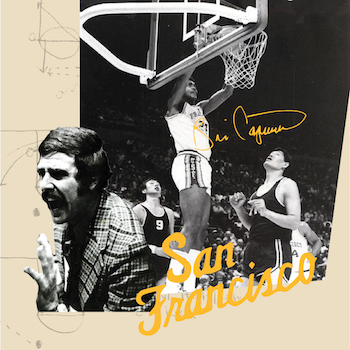
When Peletta stepped down after six seasons, the program hit a lull until one of his former players became coach in 1970–71.
Bob Gaillard had led the Dons in scoring as a senior in 1960–61. Now, as coach, he led them to conference champions behind guard Phil Smith and forward Kevin Restani. The two future NBA players played side by side for three WCC championship seasons.
In the summer of 1975, Gaillard landed three of the top six recruits in the country when he signed 7-foot Bill Cartwright, 6’9” James Hardy, and 6’7” Winford Boynes.
USF went to the NIT when the three were freshmen. But USF’s trio was just getting started, and they were joined by guards Chubby Cox and Rod Williams and 6’6” swingman Marlon Redmond from the city’s Balboa High School.
The Dons opened the 1976–77 season ranked No. 11 in the country and won their first 13 games, including the Rainbow Classic in Hawaii. When the Dons returned to the mainland, they were ranked No. 1.
“That was amazing,” Cartwright says. “We were like, ‘Wow! We must be pretty good. We didn’t think we were doing anything special; we were just playing our normal game. But then Sports Illustrated came out and started filming us. The next thing you know, I’m on the cover. It’s like, what the heck, this is crazy.”
They were 29–0 going into their final regular season game, a non-conference matchup against Notre Dame in South Bend.
“It was a bizarre trip,” Cartwright says. “When we got there, it was snowing, then the bus broke down. When we got to the hotel, there was no heat. That night, I slept in my sweats.”
The Irish were fighting for a spot in the NCAA tournament and head coach Digger Phelps had the whole school fired up. USF’s winning streak came to an end with a 93–82 loss. The Dons also lost to UNLV in the first round of the tournament.
But the Dons came back the next year, winning another conference championship. Cartwright and Hardy missed time with injuries, but the Dons opened the NCAA tournament with a 68–64 win over national power North Carolina.
Suddenly the Final Four seemed within reach.
Needing a win over Cal State Fullerton to reach the West Region finals, the Dons blew a 15-point lead and lost, 73–70.
The Cartwright-Hardy-Boynes era came to an end. Hardy and Boynes went to the NBA. Cartwright stayed on to graduate, averaging 24.5 points and 15.7 rebounds as he and senior forward Doug Jemison led the Dons to their sixth conference title in eight seasons. The Dons trounced BYU in the 1979 NCAA tournament opener but lost to UCLA in the regional semifinal after leading 43–41 at halftime.
It was a tough way to end it, but Cartwright, who played with the New York Knicks and the Chicago Bulls, says, “I was fortunate to be part of something special. It was great, it was exactly what I wanted. I was able to blaze my own trail and make my own mark.”
Program Shuts Down
Cartwright and Jemison were gone but the program seemed strong under Coach Dan Belluomini. Talented players came to the Hilltop: guards like Quintin Dailey and Ken McAllister, forwards like John Hegwood and Bart Bowers, and center Wallace Bryant.
The Dons won conference titles in 1980 and 1981 and reached the NCAA tournament again in 1982.
But the program ran into trouble. Recruiting violations put USF on probation in 1979–80. Belluomini was dismissed.
Then it all came to a stop. Dailey was accused of sexually assaulting a resident adviser on campus and pleaded guilty to aggravated assault. He was sentenced to three years of probation and acknowledged he had been paid for a nonexistent job while at USF. Faced with more potential NCAA violations, USF President John Lo Schiavo, S.J., shut down the program in 1982.
“The university cannot afford to pay the price the basketball program is imposing on it,” Fr. Lo Schiavo said.
His decision made headlines, but Fr. Lo Schiavo said it was necessary to repair USF’s reputation. Three years later, in 1985, he reinstated the program, establishing stricter controls over recruiting. And he picked former player Jim Brovelli, the guard who led the team to the NCAA tournament in the early 1960s, to resurrect basketball on the Hilltop.
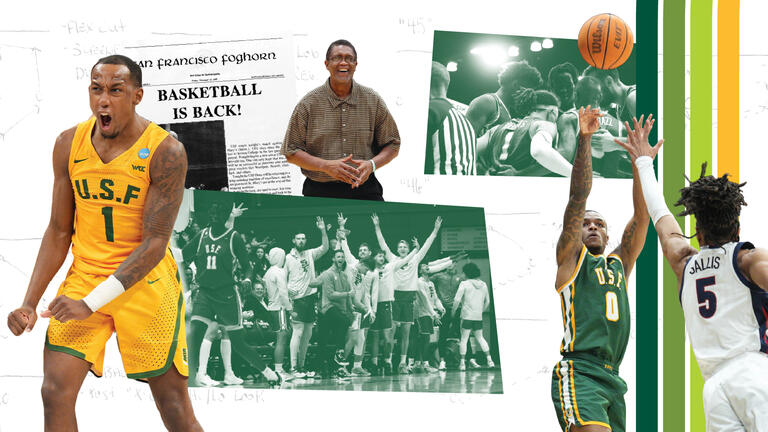
Dons Return
It took years for the program to rebuild, and the team has returned to the NCAA tournament just twice in the past 25 years. Under Coach Phil Matthews, the Dons played in the NCAA tournament in 1997–98, after upsetting Gonzaga in the WCC championship game. The Dons lost in the first round to Utah.
The program started to rise under coach Kyle Smith, hired in 2016. The Dons had three 20-win seasons under Smith before he left for Washington State. Assistant coach Todd Golden took over, and the Dons returned to the tournament in 2021–22, with guards Jamaree Bouyea and Khalil Shabazz leading the way to a 24–10 record and an at-large berth. An overtime loss to Murray State knocked USF out in the first round.
It has now been 44 years since the Dons have won a game in the NCAA tournament. But Gerlufsen, Cartwright, Brovelli, and those who have been around the program and understand the tradition on the Hilltop still believe the past is prologue for what is to come.
“I think our players are aware and have respect for the, history and tradition of the school,” says Cartwright. “My job is to make sure they understand it. We are as good or better than anybody. We have that tradition. We just need to put people in position to be successful. It’s doable here. It’s happened here. I’ve been a part of it. I’m very excited about what’s happening here. It’s a great time for us.”
TR Sullivan was sports editor of the San Francisco Foghorn and graduated in 1981. He spent 40 years as a sports reporter in Texas for the Denison Herald, Fort Worth Star-Telegram, and MLB.com before retiring in 2020.
Catch a Home Game
The Dons play at War Memorial at the Sobrato Center. For tickets, go to USFDons.com.
Date, Opponent
Jan. 13, Portland
Jan. 18, Loyola Marymount
Jan. 20, Saint Mary’s
Feb. 1, San Diego
Feb. 3, Pacific
Feb. 10, Santa Clara
Feb. 24, Pepperdine
Feb. 29, Gonzaga